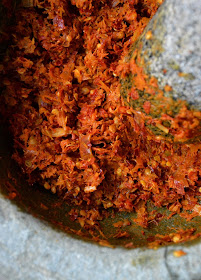Fresh ginger, galangal, turmeric, coriander seeds, dried and fresh red chillies, garlic and shallots are all used for the spice paste for the Perakan dish of Acar Awak, kind of spicy chili pickles. I'm quite obsessed with them, and snack them directly from the jar while waiting for the dinner...
I'm not aspiring to be a food blogger, even if I have loved to cook ever since I was able to hold the spatula; there are enough awe-inspiringly creative food writers out there already, many of whom also are stunningly talented gardeners (actually, I wouldn't be at all surprised if some ambitious scientist would figure out that the genes ruling our love for these two areas are closely connected...) But I just wanted to post some pictures of my newest fancy, which is pounding my own spice pastes for the Peranakan dishes I've started to love since we moved to Singapore.
Candlenuts and blanchan, a dried shrimp paste that needs to be toasted before using, are two other necessities for the Acar Awak spice paste, here on small traditional Peranakan dish decorated with peonies and phoenixes (two motifs loved by the Peranakan for their auspicious symbolism) for serving condiments at the dining table.
I'd been in several Asian countries, inclusive Singapore and Malaysia, long before last year's move, but I'd only skimmed the surface what comes to the local cuisines. Being a multicultural country, the dishes here are as manifold as the people making and eating them: people of Chinese origin form the majority here, but there are even large populations of Malay, Indian and Eurasian decent. The Peranakan subculture has strong and living roots here, and the cuisine is proudly prepared in families and served by many local restaurants and food stalls (as I wrote in my previous post, these middle class professionals and wealthy merchants were descendants of Chinese, Indian and even European immigrants who married native girls from the Malay Archipelago - the Malay term ‘peranakan’ means literally ‘locally born’; these intermarriages occurred as early as in the 14th and 15th centuries when trading between the different areas started to develop).
After some vigorous pounding, the paste starts to take form in the mortar (it took me almost 45 minutes to get to this stage... at least I'm getting good muscles from these "heritage projects"!).
"Sunning" the vegetables for a couple of hours is an important phase in the cooking process - they develop more taste and become more crunchy.
The thing is, when you develop a love for the local dishes, from the coconut-scented laksa soup to nonya and all other types of curries, you realize that pastes from the supermarkets don't get you even near to how the dishes really should taste. And while food processors are fast, only pounding by hand really brings out the deeper aromas of the ingredients like galangal, turmeric, ginger, coriander seeds, garlic, dried and fresh chillies and little shallots to mention just a few. Luckily, when I was browsing through some of the junk/antique shops in the backstreets of Singapore, I bought a huge old stone mortar with a pestle, almost too heavy to handle, but wonderful when you need to prepare larger amounts of spices. And it hasn't been idle in the back of the storage room; I've been pounding away all kinds of pastes several times a week, sometimes with tears running from the large amounts of chili and shallots often required in the recipes. So even if not quite keeping to the subject of my blog, here are some pictures from my latest food adventures among the local cuisine of Singapore.
The completely addictive end results of Acar Awak (unfortunately, in a Japanese bowl, I might need to go back to my junk shop and buy a Peranakan porcelain one to be even more authentic...where does it end?)






No comments:
Post a Comment